Economic Optimization of Thermal Insulation Thickness for Insulated and Electrically Traced Pipelines in Drilling Applications
Abstract
:1. Introduction
2. Method
2.1. Economic Thickness Method for Insulated Pipelines
2.2. Economic Thickness Method of Electric Tracing and Insulation Pipeline
3. Results and Discussion
3.1. Validation
3.2. Effect of Pipe Diameter on Economic Thickness and Cost
3.2.1. Insulated Pipes
3.2.2. Electric Tracer Pipes
3.3. Effect of Average Drilling Fluid Temperature on Economic Thickness and Cost
3.3.1. Insulated Pipes
3.3.2. Electric Tracer Pipes
4. Conclusions
- (1)
- The data reveal that both the pipe diameter and the running time substantially affect the economic thickness of the insulation. Notably, when operating for 3600 h with drilling fluid temperatures between 10 °C and 50 °C, the economic thickness per unit length of the insulation layer increases dramatically by 97.77% from 1.79 cm.
- (2)
- The thermal conductivity of the insulation material and the temperature of the drilling fluid are pivotal in determining the economic thickness. High values of these parameters necessitate increased insulation thickness to maintain efficiency. The optimal design thickness should, therefore, be established based on the maximum allowable heat loss to ensure operational efficiency.
- (3)
- Similar trends observed in thermal insulation pipelines are evident in electric tracing pipelines, where the economic thickness escalates with increases in pipe diameter, running time, insulation material, and fluid temperature. Additionally, the economic thickness of electric tracing pipelines surpasses that of non-electric tracing pipelines, leading to higher costs per unit length in the electric tracing systems.
- (4)
- For a pipeline with a running time of 3600 h using DN100 rock wool insulation, the total cost per unit length for the electric tracing pipeline is notably higher, by CNY 19.72, than that for the non-electric tracing pipeline.
- (5)
- The findings from this study highlight the critical need to tailor insulation designs to the specific operational conditions and environmental requirements of drilling sites. Future research should focus on exploring new materials and advanced technologies to further enhance the cost-effectiveness and thermal efficiency of insulation systems in such challenging environments.
Author Contributions
Funding
Data Availability Statement
Acknowledgments
Conflicts of Interest
References
- Wang, D. Heat loss along the pipeline and its control measures. SN Appl. Sci. 2023, 5, 2. [Google Scholar] [CrossRef]
- Guan, Z.; Qin, M.; Wang, H.; Xia, Y.; Zhang, Y.; Jiang, Y. Thermal insulation and underlayer corrosion in petroleum and petrochemical industries. Mater. Prot. 2022, 55, 154–163. (In Chinese) [Google Scholar]
- De Rosa, M.; Bianco, V. Optimal insulation layer for heated water pipes under technical, economic and carbon emission constraints. Energy 2023, 270, 126961. [Google Scholar] [CrossRef]
- Liu, H.; Bai, L.; Guo, Y. Sensitivity analysis of factors affecting heat loss in horizontal direct buried heating pipeline. J. Jilin Jianzhu Univ. 2020, 37, 41–48. [Google Scholar]
- Yan, Q.; Meng, Z.; Luo, J.; Wu, Z. Experimental study on improving the properties of rock wool and glass wool by silica aerogel. Energy Build. 2021, 247, 111146. [Google Scholar] [CrossRef]
- Zheng, Q.; Wang, W. Calcium silicate based high efficiency thermal insulation. Br. Ceram. Trans. 2000, 99, 187–190. [Google Scholar] [CrossRef]
- Zhong, S. Study on Thermal Insulation and Heat Dissipation Performance of Thermal Steam Pipeline and Its Influence on Economy. Ph.D. Thesis, Zhejiang University, Hangzhou, China, 2019. [Google Scholar]
- Bahadori, A. Chapter Three—Material Selection for Thermal Insulation. In Thermal Insulation Handbook for the Oil, Gas, and Petrochemical Industries; Gulf Professional Publishing: Houston, TX, USA, 2014; pp. 239–301. [Google Scholar]
- Lee, L.; Ingenhoven, P.; Saw, W.L.; Nathan, G.J.G. The techno-economics of transmitting heat at high temperatures in insulated pipes over large distances. Appl. Energy 2024, 358, 122634. [Google Scholar] [CrossRef]
- Balzamova, E.Y.; Balzamov, D.S.; Bronskaya, V.V.; Minnegalieva, C.B.; Khairullina, L.E.; Khabibullina, G.Z.; Ignashina, T.V.; Kharitonova, O.S. Analysis of the issue of the selection, operation and improvement of thermal insulation materials for pipelines of heating networks. J. Phys. Conf. Ser. 2021, 2094, 052028. [Google Scholar] [CrossRef]
- Daşdemir, A.; Ertürk, M.; Keçebaş, A.; Demircan, C. Effects of air gap on insulation thickness and life cycle costs for different pipe diameters in pipeline. Energy 2017, 122, 492–504. [Google Scholar] [CrossRef]
- Zhou, T.; Gao, J.; Sun, Z.; Li, J.; Zhang, J. Application of aerogel felt in pipeline insulation. Petrochem. Des. 2019, 36, 64–66+8. [Google Scholar]
- Wu, J.; Wang, H.; Gu, J. Study on thermal insulation structure characteristics of new prefabricated overhead thermal insulation pipeline. Dist. Heat. 2019, 40, 140–144. [Google Scholar]
- Wang, Y.P.; Tu, Z.T.; Yuan, L.Y. Analysis of thermal energy storage optimization of thermal insulation material and thermal insulation structure of steam pipeline. Therm. Sci. 2020, 24, 3249–3257. [Google Scholar] [CrossRef]
- Wu, R.; Zhang, Y.; Shen, J. Analysis of Influencing factors on thermal insulation Performance of Multi-layer Reflection Structure of Pipeline. Pipeline Technol. Equip. 2022, 2, 24–27. [Google Scholar]
- Shammazov, I.; Karyakina, E. The LNG Flow Simulation in Stationary Conditions through a Pipeline with Various Types of Insulating Coating. Fluids 2023, 8, 68. [Google Scholar] [CrossRef]
- Zhang, L. Fault analysis and Main points of on-site supervision and inspection of thermal insulation of electric trace in oil and gas field pipelines. China Pet. Chem. Stand. Qual. 2021, 41, 43–44. [Google Scholar]
- Hong, Z.; Zhong, F.; Yang, C. Design and Selection of thermal insulation and electric tracing for tower solar thermal power station system. Turbine Technol. 2023, 65, 262–264. [Google Scholar]
- Yang, R.S.; Xu, D.; Duan, C.; Ge, Y.Y.; Zhang, M.R. Calculation and Analysis on Thermodynamics Calculation of Nature-Gas Pipelines with Electric Heat Tracing. Appl. Mech. Mater. 2013, 2715, 91–96. [Google Scholar] [CrossRef]
- Lardear, J.L. Control of self-regulating heating cable for use in pipeline heating applications. IEEE Trans. Ind. Appl. 1991, 27, 1156–1161. [Google Scholar] [CrossRef]
- Wang, Z.; Liang, J.; Wang, M. Engineering design of oil recovery and transportation with electric heat tracing. J. Univ. Pet. China Nat. Sci. Ed. 1998, 22, 38–40+115. [Google Scholar]
- Li, Y.F.; Chow, W.K. Optimum insulation-thickness for thermal and freezing protection. Appl. Energy 2005, 80, 23–33. [Google Scholar] [CrossRef]
- Ma, D.; Gao, B. Selection and design of electric heat tracing. Shandong Chem. Ind. 2014, 43, 113–117. [Google Scholar]
- Luo, H. Design and application of electric heat tracing in petrochemical instruments and pipelines. Chem. Autom. Instrum. 2022, 49, 538–541+551. [Google Scholar]
- Yu, J.H.; An, C.; Tang, Q.S.; Zhang, J.X.; Zhang, Y. Heat transfer characteristics of subsea long-distance pipeline subject to direct electrical heating. Geoenergy Sci. Eng. 2024, 234, 212679. [Google Scholar] [CrossRef]
- Li, X. Research on Thickness Optimization and Economy of Thermal Insulation Layer of Direct-Buried Steam Pipeline. Master’s Thesis, Yanshan University, Qinhuangdao, China, 2021. [Google Scholar]
- Ai, Z. Research on Optimal Design of Pipeline Insulation Structure. Master’s Thesis, Changsha University of Science and Technology, Changsha, China, 2010. [Google Scholar]
- Guo, Z.; Mo, G.; Zhang, T.; Yue, M.; Liu, Z.; Li, C.; Zhang, X. Thickness design of thermal insulation layer for long-distance overground oil pipeline. J. Yangtze Univ. Nat. Sci. Ed. 2021, 18, 90–97. [Google Scholar]
- Li, S.; Liu, B.; Qi, J.; Liu, L.; Li, Q. Design of insulation layer thickness for overhead high temperature oil pipeline. Contemp. Chem. Ind. 2011, 40, 97–99. [Google Scholar]
- Luo, S. Discussion on the influence of heat insulation and insulation on the operation of pipelines in petrochemical enterprises. Guangdong Chem. Ind. 2018, 45, 178–179. [Google Scholar]
- Açıkkalp, E.; Yerel Kandemir, S. Optimum insulation thickness of the piping system with combined economic and environmental method. Energy Sources Part A Recovery Util. Environ. Eff. 2018, 40, 2876–2885. [Google Scholar] [CrossRef]
- Fan, S.H.; Chang, M.L.; Wang, S.X.; Quan, Q.; Wang, Y.; Li, D. Study on the Economic Insulation Thickness of the Buried Hot Oil Pipelines Based on Environment Factors. Comput. Model. Eng. Sci. 2020, 124, 45–59. [Google Scholar] [CrossRef]
- Salem, E.A.; Khalil, M.F.; Sanhoury, A.S. Optimization of insulation thickness and emissions rate reduction during pipeline carrying hot oil. Alex. Eng. J. 2021, 60, 3429–3443. [Google Scholar] [CrossRef]
- Li, F.; Jie, P.F.; Fang, Z.; Wen, Z.M. Determining the optimum economic insulation thickness of double pipes buried in the soil for district heating systems. Front. Energy 2020, 15, 170–185. [Google Scholar] [CrossRef]
- Zhang, T.H.; Li, A.Q.; Hari, Q.; Li, X.P.; Rao, Y.D.; Tan, H.Y.; Du, S.H.; Zhao, Q.X. Economic thickness and life cycle cost analysis of insulating layer for the urban district steam heating pipe. Case Stud. Therm. Eng. 2022, 34, 102058. [Google Scholar] [CrossRef]
- Li, P.; Ge, S.; Abudukelmu Paerhat, T.; Manhong, L.D. Influence of thermal parameters of heavy oil surface steam pipeline and optimization of thermal insulation thickness. Therm. Sci. Technol. 2022, 21, 144–150. [Google Scholar]
- Zhang, L.Y.; Zhang, Q.Z.; Yang, X.H.; Hooman, K. Thermo-Economic Assessment on Insulation Conditions of the Buried Heating Pipeline for District Heating. Heat Transf. Eng. 2023, 44, 1140–1156. [Google Scholar] [CrossRef]
- GB 50264-2013; Design Code for Thermal Insulation Engineering of Industrial Equipment and Pipelines. China Planning Publishing House: Beijing, China, 2013.

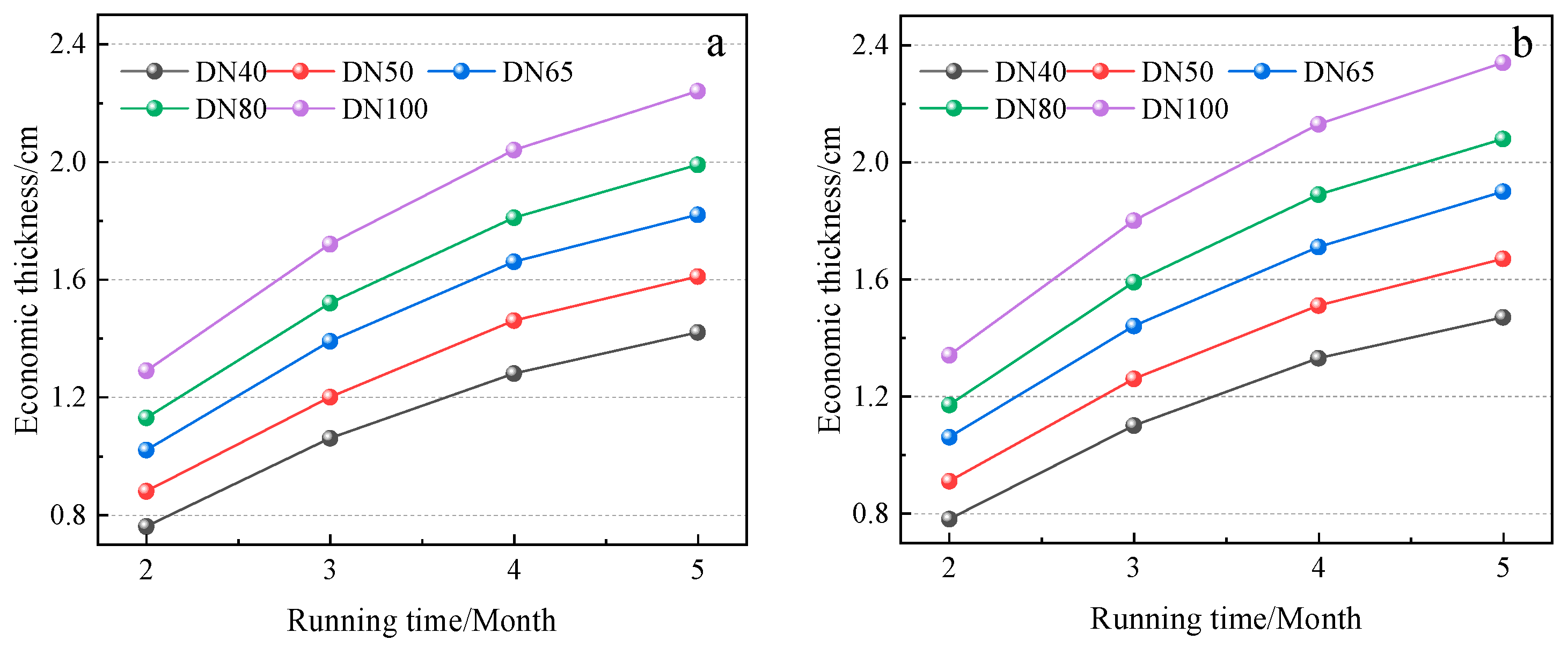
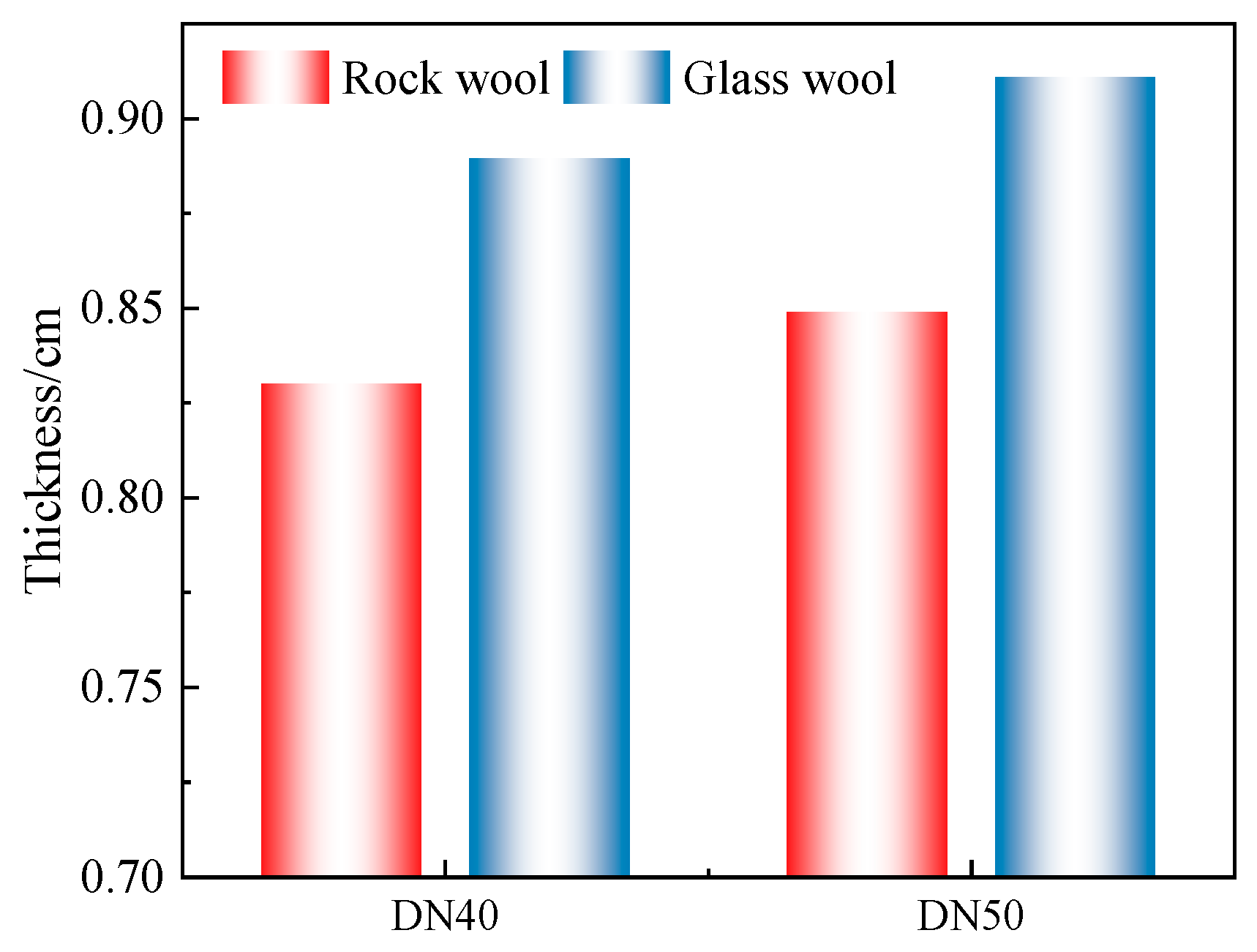

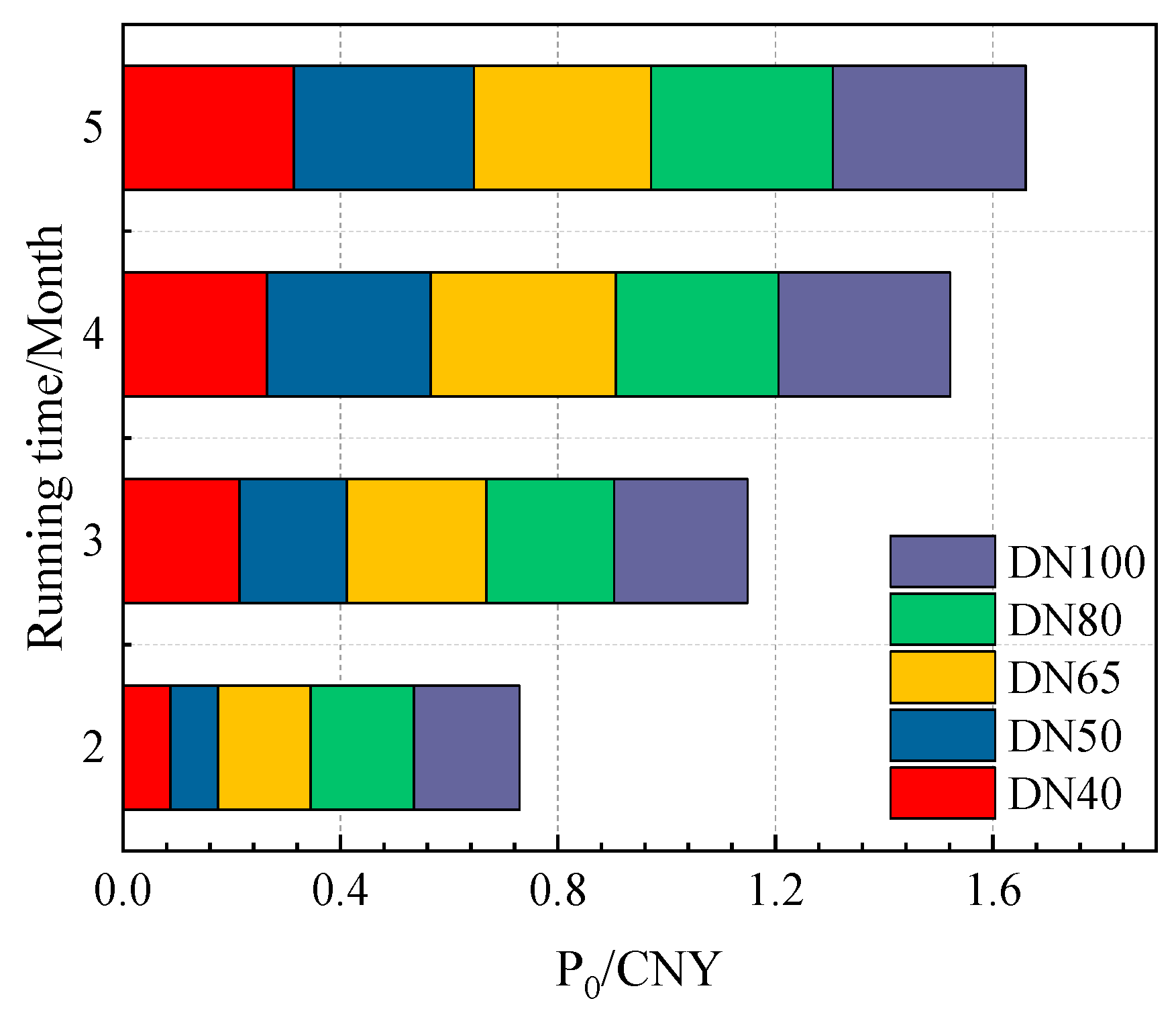


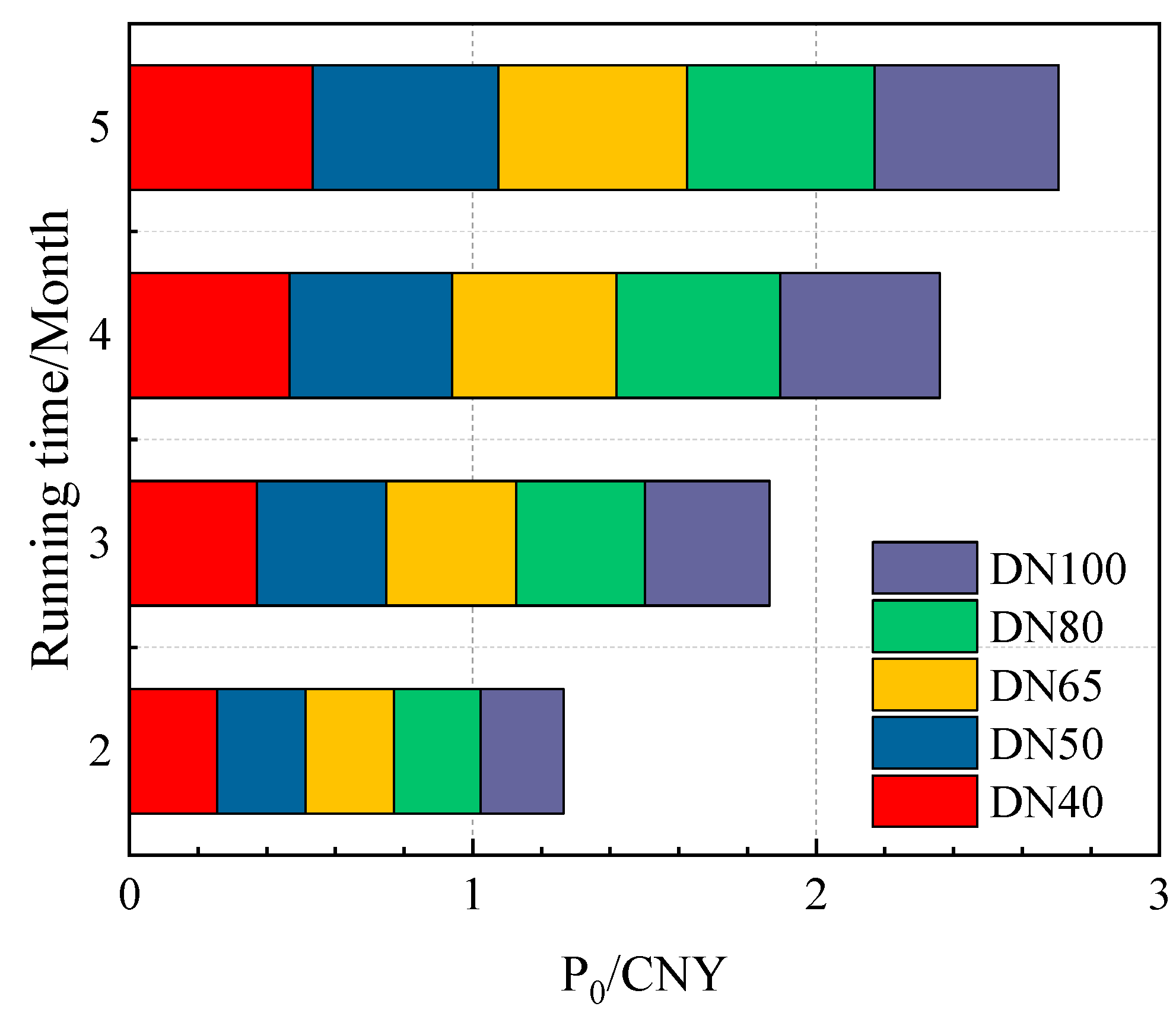
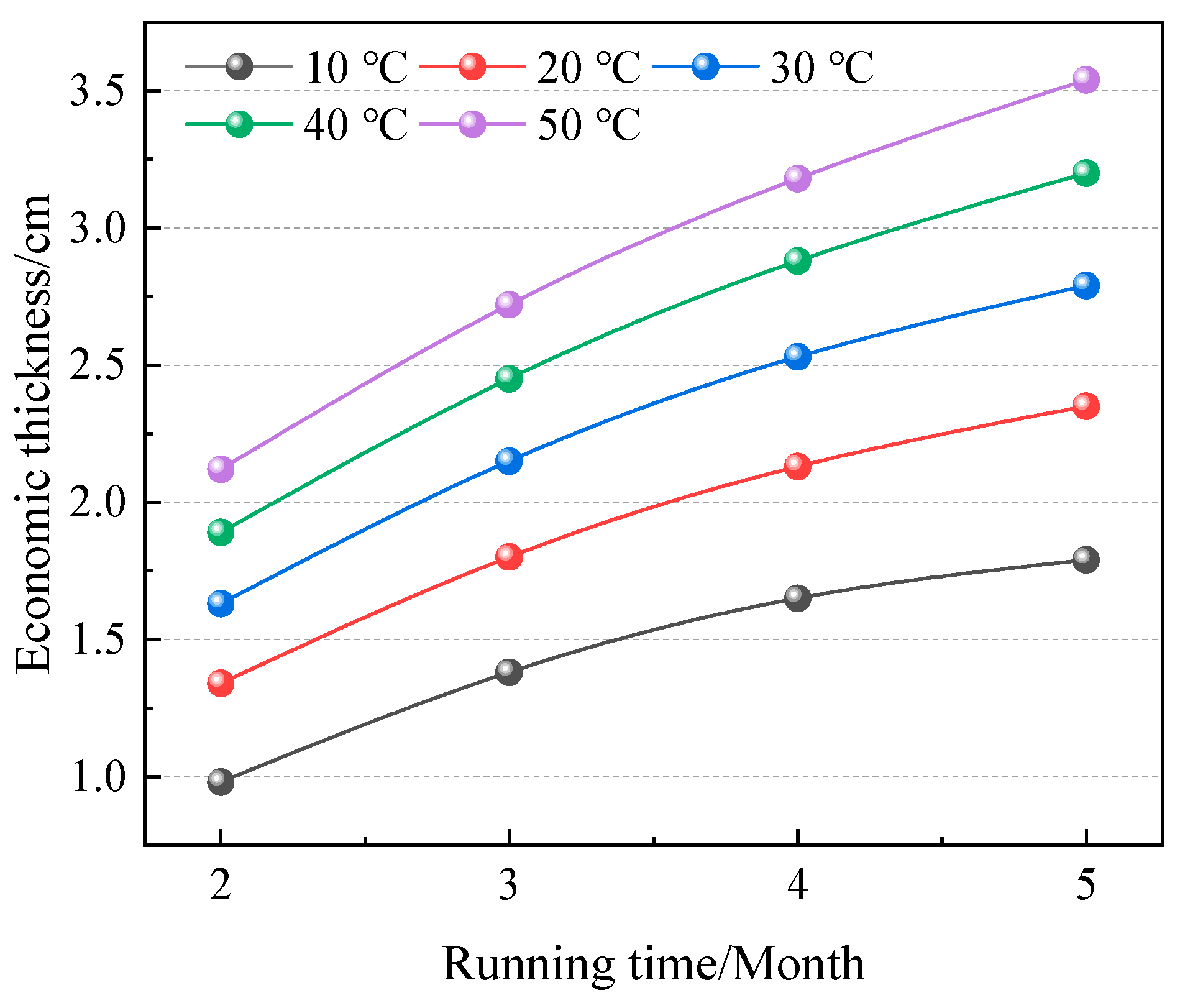
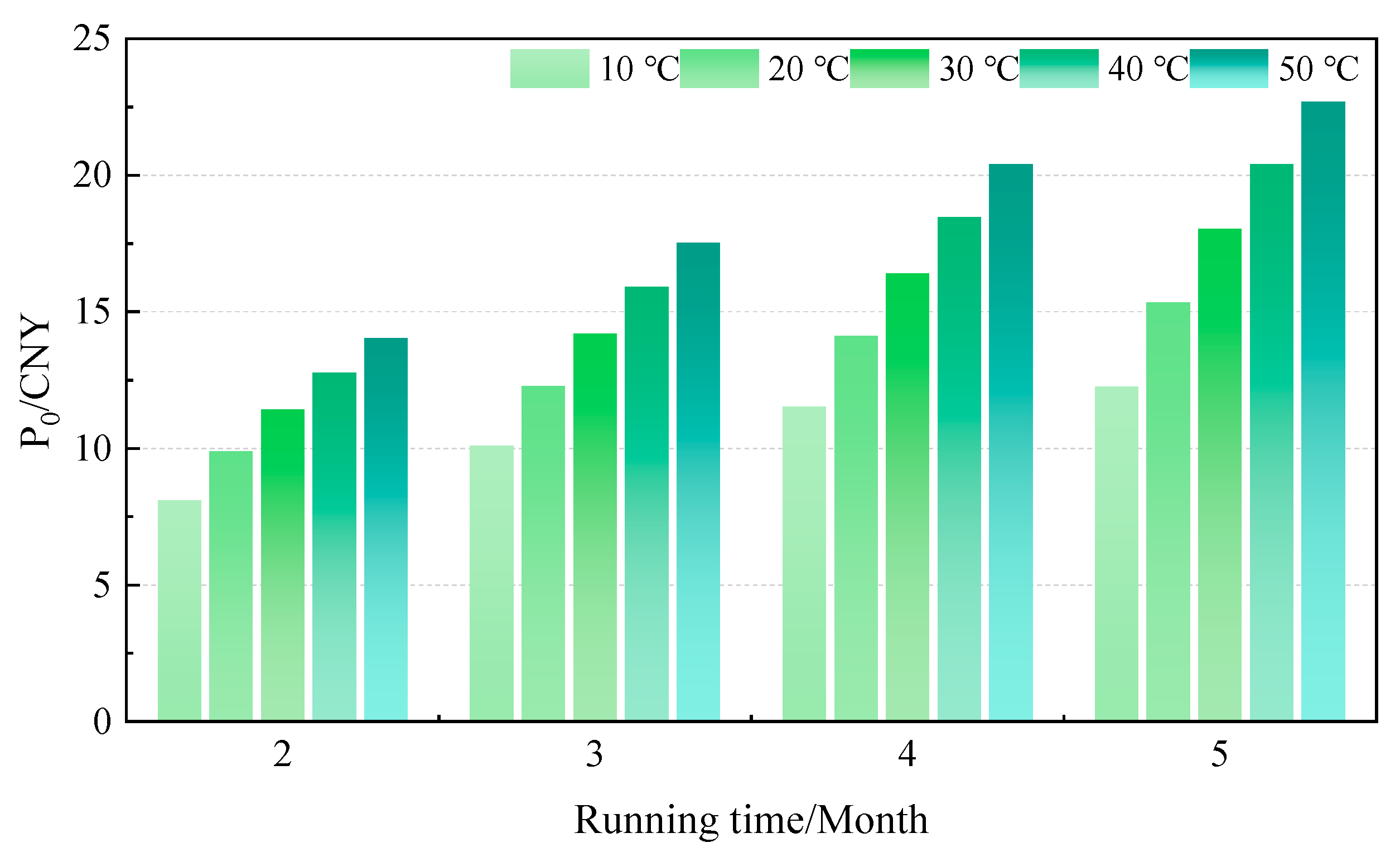
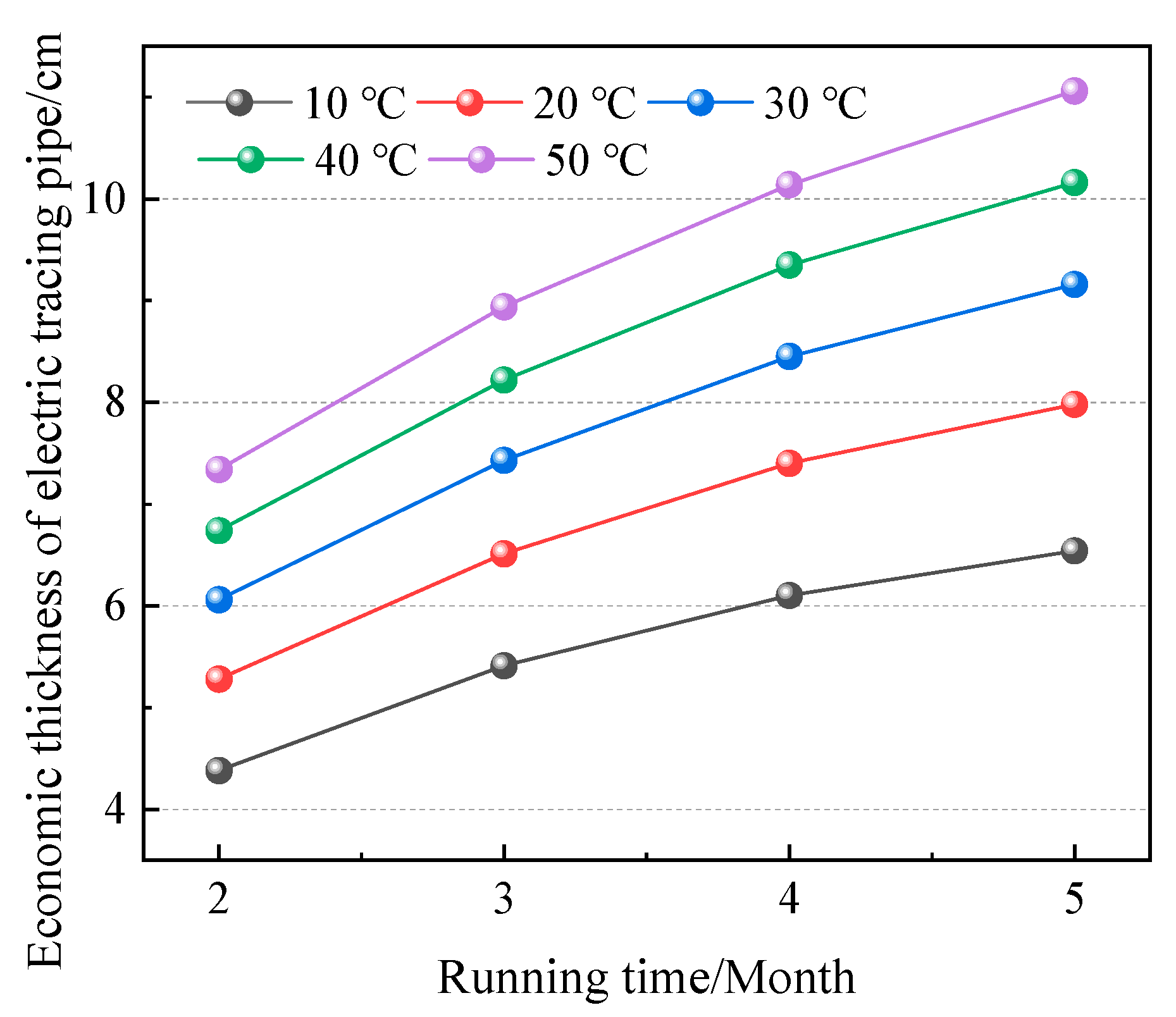
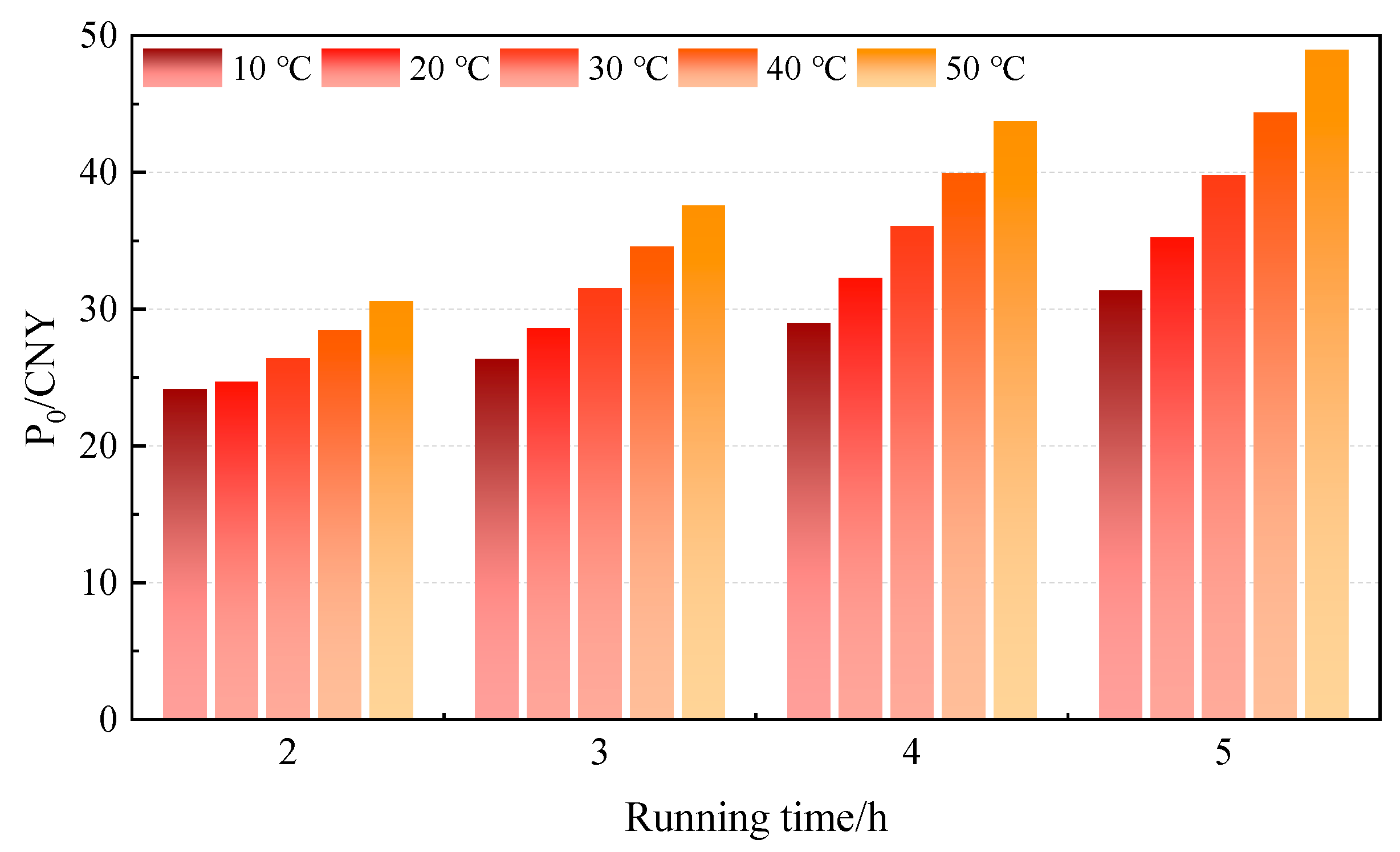
| Study | Focus | Material(s) Used | Overall Thermal Resistance (m2·K/W) | Thermal Conductivity (W/m·K) | Overall Thickness (mm) | Findings |
|---|---|---|---|---|---|---|
| Daşdemir et al. [11] | Effect of air gap | Various | 1.5 | 0.04 | 100 | Air gap in large-diameter pipes significantly impacts insulation thickness. |
| Zhou et al. [12] | Composite insulation structure | Aerogel, traditional | 2.0 | 0.018 | 50 | Proposed composite insulation structure with aerogel coupled with traditional materials. |
| Wu et al. [13] | Insulation material comparison | Soft (glass wool, etc.) | 1.8 | 0.034 | 80 | Summarized advantages and proposed new overhead insulation pipeline structure. |
| Wang et al. [14] | Stability of insulation | Aerogel, gel | 2.5 | 0.02 | 60 | Recommended using 10 mm aerogel for inner layer and 50 mm gel for outer layer. |
| Wu et al. [15] | Reflective insulation | Reflective screens | 2.2 | 0.022 | 70 | Designed multi-layer reflective heat insulation structure for pipelines. |
| Shammazov et al. [16] | Insulation coating | PU foam | 2.1 | 0.025 | 65 | Found that PU foam insulation could increase fluid temperature by 0.61 K. |
| Running Time/h | Heat Loss of Economic Thickness of Different Pipe Diameters/W/m2 | ||||
|---|---|---|---|---|---|
| DN40 | DN50 | DN65 | DN80 | DN100 | |
| 1440 | 81.06 | 73.09 | 65.66 | 60.85 | 55.07 |
| 2160 | 65.97 | 60.33 | 53.92 | 50.42 | 45.86 |
| 2880 | 55.51 | 50.29 | 45.67 | 42.79 | 39.04 |
| 3600 | 47.49 | 43.24 | 39.47 | 36.87 | 33.67 |
| Running Time/h | Heat Loss of Economic Thickness of Different Pipe Diameters/W/m2 | ||||
|---|---|---|---|---|---|
| DN40 | DN50 | DN65 | DN80 | DN100 | |
| 1440 | 84.02 | 75.38 | 67.51 | 62.81 | 56.74 |
| 2160 | 67.87 | 61.45 | 55.67 | 51.61 | 46.96 |
| 2880 | 57.07 | 51.98 | 47.43 | 43.87 | 40.06 |
| 3600 | 49.02 | 44.58 | 40.46 | 37.77 | 34.53 |
| Running Time/h | Average Drilling Fluid Temperatures/°C | ||||
|---|---|---|---|---|---|
| 10 | 20 | 30 | 40 | 50 | |
| 1440 | 45.43 | 56.74 | 65.80 | 73.09 | 79.54 |
| 2160 | 38.71 | 46.96 | 53.52 | 59.21 | 64.19 |
| 2880 | 33.13 | 40.06 | 45.56 | 50.21 | 54.54 |
| 3600 | 28.18 | 34.39 | 39.56 | 43.50 | 47.32 |
Disclaimer/Publisher’s Note: The statements, opinions and data contained in all publications are solely those of the individual author(s) and contributor(s) and not of MDPI and/or the editor(s). MDPI and/or the editor(s) disclaim responsibility for any injury to people or property resulting from any ideas, methods, instructions or products referred to in the content. |
© 2024 by the authors. Licensee MDPI, Basel, Switzerland. This article is an open access article distributed under the terms and conditions of the Creative Commons Attribution (CC BY) license (https://creativecommons.org/licenses/by/4.0/).
Share and Cite
Xu, M.; Gao, M.; Yang, R.; Wang, K.; Yuan, Z. Economic Optimization of Thermal Insulation Thickness for Insulated and Electrically Traced Pipelines in Drilling Applications. Processes 2024, 12, 1506. https://doi.org/10.3390/pr12071506
Xu M, Gao M, Yang R, Wang K, Yuan Z. Economic Optimization of Thermal Insulation Thickness for Insulated and Electrically Traced Pipelines in Drilling Applications. Processes. 2024; 12(7):1506. https://doi.org/10.3390/pr12071506
Chicago/Turabian StyleXu, Meng, Meng Gao, Ruitong Yang, Keping Wang, and Zhe Yuan. 2024. "Economic Optimization of Thermal Insulation Thickness for Insulated and Electrically Traced Pipelines in Drilling Applications" Processes 12, no. 7: 1506. https://doi.org/10.3390/pr12071506






